EDITORIAL – Why You Should Be Playing High Command!
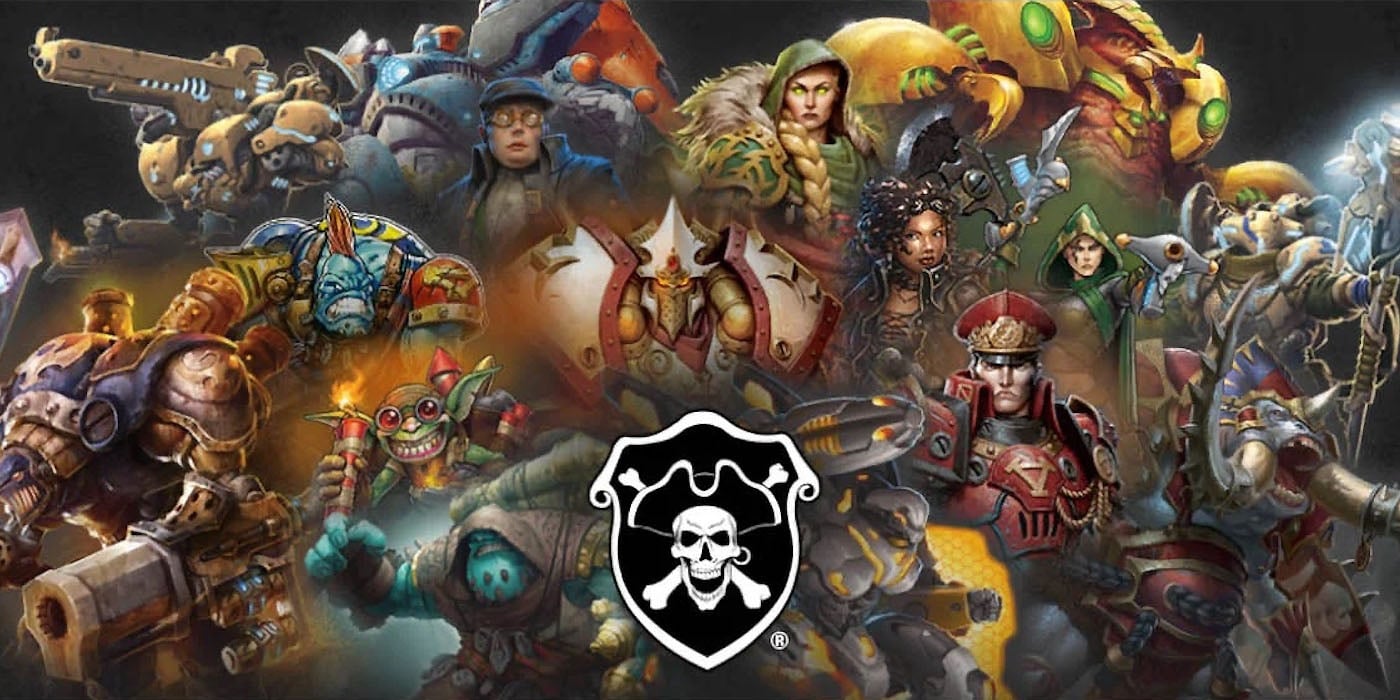
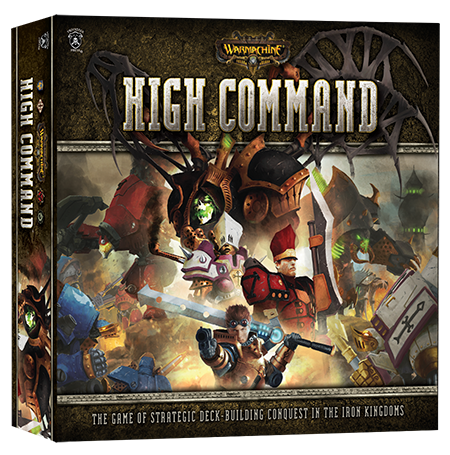 |
| Courtesy of Privateer Press Digital. Used with Permission. |
Omnus here, to explain why you should be interested in Privateer Press’s deck-building card game, High Command.
A guest piece by Charles Arrasmith, aka Omnus, of the podcast Removed From Play: Decked Out and blog Hand Cannon Online .
We live in an era of great games. It doesn’t matter if you prefer video games, card games, board games, or miniature games. There are amazingly innovative games coming out every year for every genre of games. The problem we face is that we still have the same amount of time to play games. We have to work, and some nights we have to sleep (depending on how good the game is that evening). This is making it harder and harder for us nerds to decide which games to spend our time on. There are also hundreds (if not thousands) of mediocre games coming out every year for every one incredible game. This forces us to rely on information from our peers, family, and that game store employee, to make suggestions based on what they already know we like.
I am writing this because I want to make a suggestion for you. I bet you are wondering: how could I possibly know what kind of game you enjoy playing? If the mere mention of collectable card games, living card games, and deck building games brings back hours and hours of fond memories . . . then I am talking to you. The entire goal of this article is to convince you that you should try High Command, by Privateer Press.
Why should I listen to your advice?
I have purchased games before because a store employee said they played it a half dozen times and had a blast. I have heard a glowing review by a trusted friend and purchased a game the next day. Do these situations sound familiar? I bet they do. You should take my advice because nine months of High Command left me with so much to say about the game that I had to start a podcast to get everything off my chest. I now co-host, edit, and produce Removed From Play: Deck Out, which is the first High Command podcast, because of the degree to which this game has captivated me. Intriguing deck building conundrums, fascinating decisions from turn 1, and the challenging interactive game play that Privateer Press is known for. How often does your friend say they loved the game so much that they started a podcast? I will admit; that isn’t a situation that has ever come up for me.
What is High Command?
To keep this simple, I would describe High Command as a merger between a living card game and a deck builder style board game. It retains elements from each, but can’t be described as one or the other. Privateer Press put together High Command with all of the complexity and depth of a CCG. It has the affordability and balance of an LCG, but at the core of the game it is still a deck builder with all of the replay value that genre brings to the table. Privateer Press could have taken one of the easy roads, but instead they crafted something truly unique.
The only negative to High Command for me was that the base game struggled to demonstrate the strengths that would become more apparent as the expansions were released. The original release of High Command: Warmachine and High Command: Hordes are both interesting and fun games with just the base supply of cards. I would say they are well worth the purchase, even if you never buy the expansions. But I feel that this game becomes absolutely incredible after you add those expansions.
What are the core mechanics of High Command?
I am not going to go into a full tutorial in this article, but you can watch an instructional tutorial here.
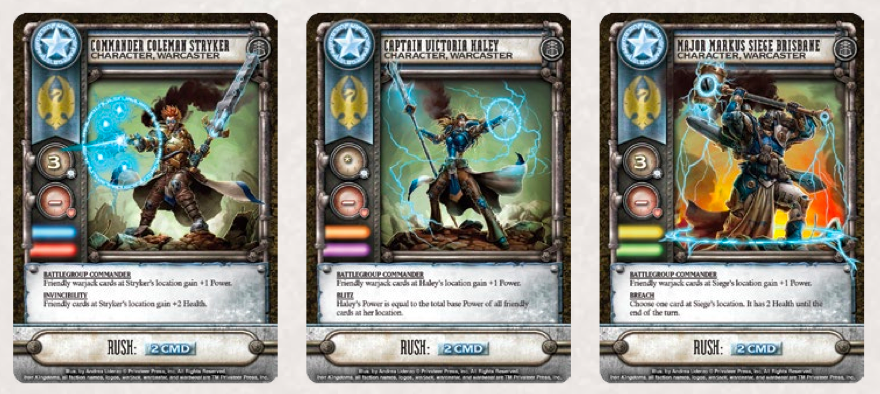 |
| Three warcaster examples Courtesy of Privateer Press Digital. Used with Permission |
Deck Building: You begin by selecting a faction and 3 Warcasters (Warmachine) or 3 Warlocks (Hordes). Each Warlock or Warcaster has 2 detachment colors that they can bring with them to your deck, and you choose 1 detachment for each Warlock or Warcaster. This means that each player’s Reinforcement Deck contains 3 detachments. Each detachment is 12 cards. In the base game, you get exactly 12 cards per detachment, but each expansion adds additional cards, so you can customize which 12 cards you want to bring. The reinforcement deck will create your marketplace during a game. Or more simply, this is the deck that you can buy cards from to add your deck in the game.
Purchasing Cards: Your army deck starts with 12 basic resource cards; you start the game by drawing 6 cards initially, and you draw 6 cards at the end of each turn. Each card can be discarded for War Resources or Command Resources (never both) to buy cards from your Reinforcement Deck. The top 4 cards of your Reinforcement Deck are laid face up in front of you, and you can buy any of these by discarding resource cards from your hand. The purchase price of cards is measured in Command, War, or both. Each time you purchase a card, you put it in your discard pile along with the resources you used to buy it. Whenever you run out of cards in your army deck, you may remove one card from your discard pile (which begins your occupied forces pile, which is the cards no longer part of any deck) and then you shuffle the discard pile together to restart your army deck with all the new cards you purchased. Like all deck building games, the goal is to increase the quality of the deck each time you reshuffle.
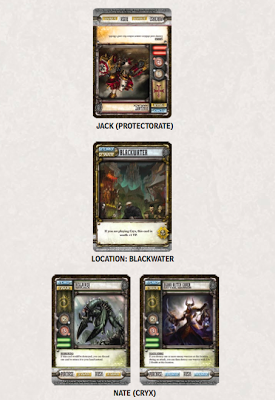 |
| Two players fighting over a location Courtesy of Privateer Press Digital. Used with Permission |
Locations: You play the game with a deck of 15 Location cards. One of the goals of the game is to capture Locations and stop your opponent from capturing. To capture a Location, you must start your turn with 2 more cards than your opponent. Each Location has special rules that affect your options and earn you Victory Points if you capture them. If you capture a Location, the cards of yours at that Location are moved; your occupied forces and the Location go to your discard pile, and they become part of your army deck the next time you shuffle. If you opponent had any cards at the Location, then they are moved to that player’s discard pile. There is one Location deck for both players
Winds of War: This game has an additional deck of 15 cards that add a special rule or a change to a rule during each round of the game. These cards range from extremely important to no effect at all. There is a single Winds of War deck for both players.
Warrior, Warjack, and Warbeast cards: These cards can be deployed or rushed to Locations to fight and try to capture them. An attack occurs at a Location at the end of each player’s turn if a Location has cards from 2 different players (or more, in a multiplayer game).
Deploying: If you draw a Warrior, Warjack, or Warbeast, you may deploy that card to a location by discarding resources equal to or more than the purchase cost of the card. You can start deploying cards at turn 3.
Rushing: If there is a Warrior, Warjack, or Warbeast in your reserves (the 4 revealed cards from your reinforcement deck that can be purchased), you pay the Rush cost of that card to send it directly to a Location instead of paying the lower purchase cost to buy it and put it in your discard pile. You can start rushing cards at turn 3.
Warlocks and Warcasters: These are once-per-game cards that can be rushed to a location to provide extra power and abilities to an attack.
Attacking: You total the power of all of your cards at the Location, and your opponent totals their power. Each player destroys cards with a combined health equal to or less than the total power. (If your opponent has a card with 5 health and one with 4 health while you have a total power of 6 . . . you can destroy either card, but not both. If you had 9 power you could destroy both cards.)
Winning: There is a card in the Winds of War that ends the game. At the end of the game, you total the Victory Points that each player earned. The person with the most is the victor. Locations are all worth victory points, and many of the cards that you can include in your detachments are also worth Victory Points.
Why should you play High Command?
I could simply say that you are nerd like me, and we love games. But I want to go into detail about the depth I am seeing as I play more games of High Command. Before I get into those details, I want to say that this game can be enjoyed as the base game with friends as the solid table top game that it is. But the expansions upgrade High Command to great strategy game. Here is why . . .
Deck Building for a Deck Building Game: This may seem like an odd concept, but it really isn’t. There are many people that grew up building decks for their favorite card game. Now they have fallen in love with the Deck Building genre of games, because they spent more time at home building decks than they ever did actually playing the game. High Command allows you to construct the pool of cards that you will be buying from your deck in the game. There are lots of interesting options, possibilities for theme decks, and the potential for multiple good decks to show up from the same faction with very different cards.
Six Detachments to Balance: Most card games live in a world where good cards get replaced by great cards. In High Command, you may skip over an amazing card because it isn’t in the right detachment. I am going to use Legion as an example. The Throne of Everblight and the Archangel are both great cards, but they are in different colors. The Archangel has two cards in the Green Detachment, two cards in yellow, and one in blue. The Throne is has two copies in purple, two copies in orange, and one in blue. Best case scenario is that you can get 6/10 of those cards in the same deck. And, depending on your selection of detachments, you may have 3 of each, 4 Archangels and 2 Thrones, or the opposite. This makes deck building more interesting and leaves lots of design space to add new powerful cards.
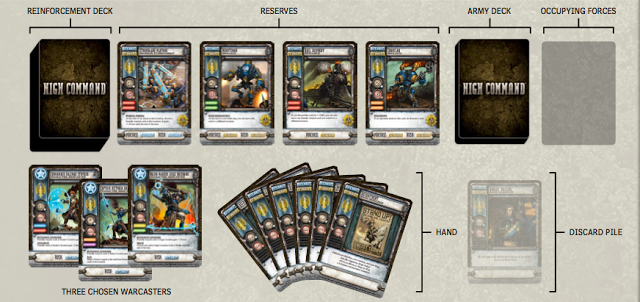 |
| The play area Courtesy of Privateer Press Digital. Used with Permission |
Four Decks: We need a certain level of randomness in our games, or we are playing Chess. Some people love and enjoy Chess. But many of our favorite board games earn our affection by having the perfect amount of random elements in the game. It is often just enough to create an interesting experience from game to game, even if you are playing the same opponent. The problem with randomness is the feeling of loss or victory being tied to the variability of the game, instead of the skill or choices you made. High Command has 4 decks that balance out the game. Your reinforcement deck, your army deck, the Location deck, and the winds of war deck each add an element to the game. Even if your opponent is getting better draws from their army deck than you are . . . you may be getting more optimal locations for your deck to fight over. In a normal card game, you have one deck that you are drawing from, and that deck’s shuffle is all that matter. It is less likely that 4 decks will all end up with a shuffle that is poor for you. This creates a random but fun and balanced situation to battle with your friends. I will say that the Invasion of Sul Campaign Expansion really helped display this strength of the game. The original Winds of War and Locations decks are very balanced, but Invasion of Sul has many more interactive cards that can provide you with routes to play your way out of a bad draw.
Game. On.
Here is the primary point I want to get across with this article: if you haven’t played High Command yet . . . do it. If you tried High Command when it first came out . . . try it again. This game has developed into an incredible strategy game, and it’s only about a year in. There are High Command communities and play groups popping up all over the world. We already know what’s coming from the next Campaign Expansion: Castle of the Keys, and we have seen previews of a few cards in High Command: Faith and Fortune. There is even more incredible stuff on the horizon.
If you read through all of this, and you still aren’t convinced . . . download an episode of Removed From Play: Decked Out. We are excited, and we will get you hooked.
It’s time to get back to some games, but before I go, I want to express my appreciation that Bell of Lost Souls invited me to blather on their great blog! I am very thankful for the opportunity to share my passion for High Command.
~Omnus
A special thanks to Omnus for sending us this article. I’ve been following his podcast, and I have enjoyed every episode they’ve released. If you have even a passing curiosity about High Command, I highly suggest checking it out!


